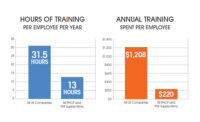by David Nour, CEO – The Nour Group
Today, every business leaderin the supply industry faces a challenge: You must manage the present while you invest in the future.
To prepare for the future, you must fundamentally reimagine your organizational strategy from your value creation model to your talent acquisition and development to your customer engagement. As you undertake this radical rethink, it is crucial to look outside the supply industry. Consider companies that have struggled: Polaroid. Borders. Blockbuster. Kodak. JC Penney. Blackberry. What do these companies have in common? Not that they failed to see industry trends; they failed to act on those trends with agility. How will you become agile?
Today the world’s largest taxi company, Uber, owns no vehicles. The most popular media owner, Facebook, creates no content. The most valuable retailer, Alibaba, owns no inventory. The largest accommodation provider, Airbnb, owns no real estate. Given that context, how are you preparing to think differently about your business? Is the day coming when Kohler owns no faucets?
Given that your industry is all about buildings and the infrastructure that goes into them, I hope you’ve been paying attention to the rise of the Internet of Things (IoT). The combination of technology and connectivity is driving dramatic improvements in product function and performance. Your customers are starting to expect elegant systems that enhance their experiences. How will you integrate these shifts into your value proposition?
Advance Your Relationships
The theme of Network 2015 is “Network: Advance Your Relationships.” I submit that relationships are your greatest off-balance-sheet asset. Every customer is now capable of being a brand evangelist who will help
you attract more customers, but only if they encounter exceptional experiences at every turn.
Customers no longer need to be sold. By the time they make their first contact with you, they already know 80% of the information required to make a purchase. Today, your brochures matter less than the stories your brand creates because stories spread value. These stories could be content experiences or conversations. The message channel could be paid, owned, earned or shared. The value in those stories transcends any individual brand to elevate your entire industry.
Return on Impact is fundamentally about building digital relationships that go beyond transactions. A new stance is required: Proactive, predictive, intuitive, visionary. Examples: Use Twitter for technical support. Put installation tutorials on your YouTube channel. Use sentiment analysis to determine the attitude of key stakeholders and customers so you can lead the market, not follow.
At Network 2015 I’ll talk about 10 ideas from my book, “Return on Impact.” I’ll share my ‘IMPACT” model to help you understand how to use social channels to drive growth.
You’ll leave radically better-prepared to reimagine your supply organization for a return on impact.




